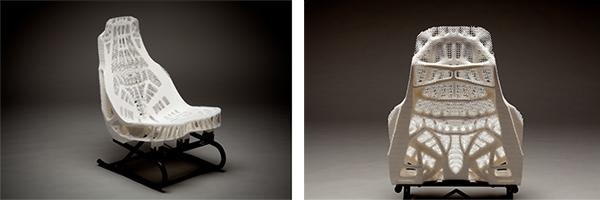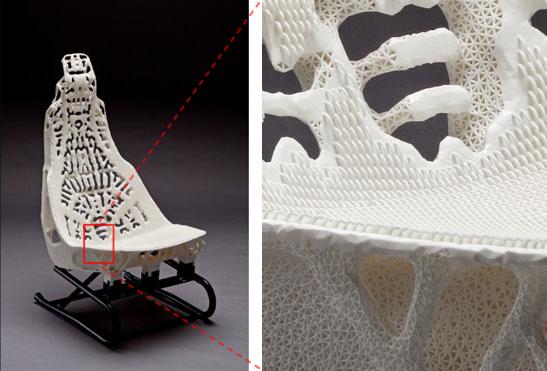Anyone who has ever sat in a the luxury of a down-filled Rococo arm chair knows that car seats aren’t the most comfortable sitting arrangement. Even if you haven’t you’ve probably noticed that there is room for improvement. Toyota thought so too, and initiated a project with Materialise to redesign the car seat so that it would be significantly lighter in weight and also be geared to optimal heat capacity.
 There are a lot of constraints in place when designing car seats, not the least of which is the fact that the several-ton machine it is in might at some point be subject to a 60mph head-on collision. So, they couldn’t just scrap all of that and strap in a barcalounger. Instead, they decided to explore the possibility of creating a complex topology through 3D printing that would give them the structure they need but without all the extra material.
There are a lot of constraints in place when designing car seats, not the least of which is the fact that the several-ton machine it is in might at some point be subject to a 60mph head-on collision. So, they couldn’t just scrap all of that and strap in a barcalounger. Instead, they decided to explore the possibility of creating a complex topology through 3D printing that would give them the structure they need but without all the extra material.
The creation of such a complex topology quickly made the 3D STL files too large and complex to effectively manage. Luckily for Toyota, there’s no saying ‘impossible’ to the team at Materialise. The first step was to assign the desired densities to each region of the chair using varying shades of gray. Then, that gray-scale data was read by Mimics, a software originally designed for the processing of medical images.
 To fill in the areas designated as low density, the engineers at Materialise designed an entirely new, project specific unit cell through 3-maticSTL. They then used this program to remove any extra edges left dangling and to add a pattern of elastic beams to the seat in order to increase the level of comfort experienced by its occupant. Calculating all of the 3D geometries while constructing this model would have made it impossible to manage; the innovative design was chock-full of unit cells and texture. However, using Materialise’s slice-based technology made it manageable by delaying those calculations until the slicing phase of the process.
To fill in the areas designated as low density, the engineers at Materialise designed an entirely new, project specific unit cell through 3-maticSTL. They then used this program to remove any extra edges left dangling and to add a pattern of elastic beams to the seat in order to increase the level of comfort experienced by its occupant. Calculating all of the 3D geometries while constructing this model would have made it impossible to manage; the innovative design was chock-full of unit cells and texture. However, using Materialise’s slice-based technology made it manageable by delaying those calculations until the slicing phase of the process.
And it was all worth the trouble. The benefit of these areas of low density is twofold. The first aspect that answered the design brief for this project was the creation of a greater ability for heat dissipation. The second benefit was an impressive savings in the amount of material required to create the seat’s structure. In fact, the volume of the car seat was reduced by a whopping 72%, an 18 kg drop from the original.
 The possibility to utilize slice-based operations technology simplified the process on a scale almost difficult to imagine. The availability of this type of ‘simplification’ tool will greatly expand the possibilities for engaging in incredibly complex design modeling with much greater ease. So, I think that now that they’ve redesigned the car seat for adults, the next step should be to redesign the baby car seat. Those things weigh a ton and exhausted new parents have to pick them up repeatedly.
The possibility to utilize slice-based operations technology simplified the process on a scale almost difficult to imagine. The availability of this type of ‘simplification’ tool will greatly expand the possibilities for engaging in incredibly complex design modeling with much greater ease. So, I think that now that they’ve redesigned the car seat for adults, the next step should be to redesign the baby car seat. Those things weigh a ton and exhausted new parents have to pick them up repeatedly.
I know Toyota hasn’t been in the business of making baby seats…but maybe they could be. Let’s hear your thoughts. Discuss in the 3D Printed Seat forum thread on 3DPB.com.
Subscribe to Our Email Newsletter
Stay up-to-date on all the latest news from the 3D printing industry and receive information and offers from third party vendors.
You May Also Like
Gorilla Sports GE’s First 3D Printed Titanium Cast
How do you help a gorilla with a broken arm? Sounds like the start of a bad joke a zookeeper might tell, but it’s an actual dilemma recently faced by...
Nylon 3D Printed Parts Made More Functional with Coatings & Colors
Parts 3D printed from polyamide (PA, Nylon) 12 using powder bed fusion (PBF) are a mainstay in the additive manufacturing (AM) industry. While post-finishing processes have improved the porosity of...
$25M to Back Sintavia’s Largest Expansion of Metal 3D Printing Capacity Since 2019
Sintavia, the digital manufacturing company specializing in mission-critical parts for strategic sectors, announced a $25 million investment to increase its production capacity, the largest expansion to its operations since 2019....
Velo3D Initiates Public Offering in a Bid to Strengthen Financial Foundations and Drive Future Growth
Velo3D (NYSE: VLD) has been among a number of publicly traded 3D printing firms that have attempted to weather the current macroeconomic climate. After posting a challenging financial report for 2023,...































